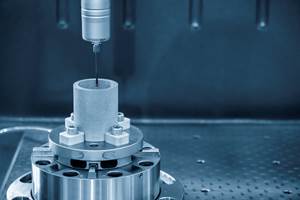The Dial Tells It All
Dial indicators—you've seen one, you've seen them all. They are all over the shop, and as you walk around, they all look the same to you.
Share






Dial indicators—you've seen one, you've seen them all. They are all over the shop, and as you walk around, they all look the same to you.
But step closer and take a long look, because we are going to examine the indicator dial in detail. No, we are not going to go inside. We are going to look at the way the indicator presents information to the user—on the dial. There are different styles of dials, and the type is determined by how the indicator is used.
Indicator dials come in two basic formats: balanced and continuous. Whether to use one or the other is very often determined by the gage and the range of the indicator. However, in general, if the tolerances are bilateral, such as ± 0.001 inch, the balanced dial is preferred. If the tolerance is unilateral such as -0.000 to +0.002 inch, a continuous dial would be the preference.
Some dial indicators are sold with a very limited range, so limited that the dial only displays one revolution of measuring range. These one-rev indicators with balance dials are designed for high magnification and to eliminate miscounting the number of revolutions the hand of the indicator travels.
Because the dial indicator is often used on a handheld gage, such as a bore gage or snap gage, the mechanical travel of the gage is really the limiting factor in the measuring range. Therefore, there is no need for the dial indicator to have long range. And, since most tolerances are bilateral, the most common dial is the balance type.
Revolution counters are used on balanced dial indicators, even though they might have only two revolutions of total travel. This is because the hand may move so fast that the eye can't keep up. A balanced dial might indicate +0.010 inch when in reality, the hand has made an additional revolution and the actual measurement is +0.110 inch. In such cases, the rev-counter is a safeguard for assuring the correct reading.
But what if that dial indicator is now mounted to a test stand or a hand gage, such as a portable thickness gage? The dial indicator is now in a gage that can measure by comparison, or if the range is long enough, it could even be used as a direct measuring gage.
In the comparison mode, the dial would be of the balance type, but we have to start watching out for how many times the hand revolves and keep track of this number. Otherwise, we could make significant measurement errors and be off by a complete revolution of the dial.
This is where the rev-counter adds a degree of safety to the result. By reading a combination of the rev-counter and the dial, a proper result can be obtained.
When the indicator is used to make a direct measurement from the reference surface, the rev-counter, in conjunction with a continuous dial, is an absolute necessity. Some long-range indicators can have 10 or more revolutions, which would be too hard to try to count and remember as the hand went around.
The result of the measurement is the number of revolutions plus the amount read on the continuous dial. But of course, you have to know how much one revolution is worth.
For example, in the photograph at right, the revolution counter shows two revolutions of the hand, or 0.200 inch, and the big hand has come to rest at the 15 main dial division, or 0.015 inch. The sum of the two readings is 0.215 inch.
Some dial indicators have more then one rev-counter because they may travel more then ten revolutions of the dial. In these cases, each rev-counter is marked with its range, and the measurement is simply the sum of the three dial readings. In such cases, it is pretty simple to take the sum of each indictor for your total reading.
Very often we take the indicator we use for granted—but take a moment and examine the indicator dial. You'll see there's a reason it looks the way it does.
Related Content
Process Control — Leveraging Machine Shop Connectivity in Real Time
Renishaw Central, the company’s new end-to-end process control software, offers a new methodology for producing families of parts through actionable data.
Read MoreParts and Programs: Setup for Success
Tips for program and work setups that can simplify adjustments and troubleshooting.
Read More4 Ways to Establish Machine Accuracy
Understanding all the things that contribute to a machine’s full potential accuracy will inform what to prioritize when fine-tuning the machine.
Read MoreHow to Choose the Correct Fixed-Body Plug Gaging Solution
The two types of fixed-body plug gages are both accurate, fast and easy to use. Consider these factors when selecting one for your gaging application.
Read MoreRead Next
AMRs Are Moving Into Manufacturing: 4 Considerations for Implementation
AMRs can provide a flexible, easy-to-use automation platform so long as manufacturers choose a suitable task and prepare their facilities.
Read MoreMachine Shop MBA
Making Chips and 91ÊÓƵÍøÕ¾ÎÛ are teaming up for a new podcast series called Machine Shop MBA—designed to help manufacturers measure their success against the industry’s best. Through the lens of the Top Shops benchmarking program, the series explores the KPIs that set high-performing shops apart, from machine utilization and first-pass yield to employee engagement and revenue per employee.
Read MoreLast Chance! 2025 Top Shops Benchmarking Survey Still Open Through April 30
Don’t miss out! 91ÊÓƵÍøÕ¾ÎÛ's Top Shops Benchmarking Survey is still open — but not for long. This is your last chance to a receive free, customized benchmarking report that includes actionable feedback across several shopfloor and business metrics.
Read More


















